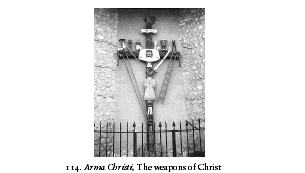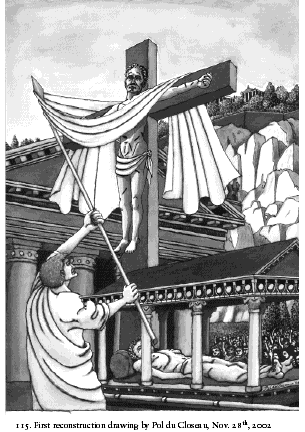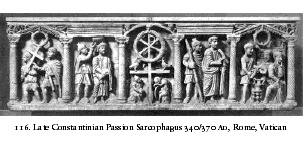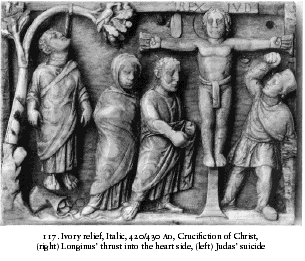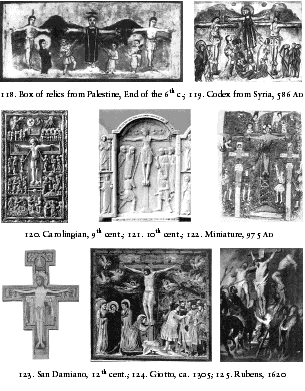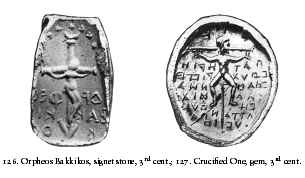Chapter III, Part 2, of the English edition
© Francesco Carotta, Kirchzarten, Germany
© 2005, Uitgeverij Aspekt b.v., Soesterberg, The Nederlands
| back to contents / previous | |||||
|
__________________________________ Crux (2) As was usual at the funeral of a
distinguished Roman, so here too the wax figure of Caesar was to be
carried in front of the bier and then placed on the Rostra, so that
during the funeral oration the people could see him as he had been in
life. But Caesar’s wax statue could not be
adorned in full robes as was the usual custom: it would have been
dressed with the triumphal robe which was none other than the red robe
of the ancient kings,[153]
the one that had made his murderers see red and decide to carry out
their assault on the tyrant. Now at this time Brutus and Cassius were
still in the city. They had managed to receive amnesty for themselves
and buy the neutrality of several veterans with the promise to
compensate expropriated landlords from the state treasury so they could
buy their properties back. Marcus Antonius, friend and relative of the
deceased and moreover holder of the office of consul and designated flamen Divi Iulii—High
priest of Divus Iulius, the new god that Caesar was to become after his
death—had to consider himself lucky to still be alive, and that
Caesar’s estates had not been auctioned, that his acts had not
been repealed, and that the Liberators who had at first planned to drag
the corpse of the tyrant through the streets and throw it into the
Tiber had instead complied with the insistence of Caesar’s
father-in-law Piso that the Pontifex Maximus should be lain to rest
with the customary honors. In the midst of this stalemate, Antonius had the momentous idea of fashioning Caesar’s wax-figure in such a way that the people would see him as he had lain after the murder—with the blood-stained toga displaying all the rents of the daggers on his martyred body, and with his arms spread out just as he had fallen. Indeed nobody had seen him there where he had fallen because they all ran for their lives after the assault—both friend and foe. Antonius, who had remained outside, fled first. But from the house tops where the people had barricaded themselves, they could see Caesar’s injured face and his arms hanging out of both sides of the litter as three of his servants carried the body home through Rome’s narrow alleys to his wife Calpurnia.[154] As this wax figure would not
have been visible if it had lain flat on the bier, Antonius ordered it
hung on the cross-like tropaeum where, as tradition required, the
insignia of victory were affixed. This created an ironic, provocative,
unbearable tropaeum, where the image of the victor himself was hung in
the midst of the trophies of war. The wax figure was still clad in his
passion garment, and the tropaeum was constructed in such a way that it
could be rotated so that everybody could clearly see it. When Piso brought Caesar’s body into the Forum, it was placed on the bier on the Rostra[155] so that the tropaeum stood at the head of the funeral bier—a golden ciborium after the fashion of the temple of Venus Genetrix, wherein lay the son of the goddess on a bed of ivory adorned with gold and purple, like the new Osiris on the womb of Isis.[156] For the funeral obsequies a
death mask of Caesar had also been made, as was the custom, so that the
deceased himself could address the funeral guests by means of a masked
actor who imitated his voice and gestures. This was sometimes done with
some levity, but on this occasion with gallows humor and deadly earnest. Both wax-images, the figure hanging on the tropaeum and the mask worn by the actor, were the main requisites of Antonius’ staging of Caesar’s funeral liturgy. And he employed them dramatically.[157] ‘During the performance
verses were sung which would evoke emotions of compassion and
indignation, such as the line from Pacuvius’ “Contest for the Arms of Achilles”: With the reading of the will the
atmosphere changed completely, because the supposed tyrant now proved
himself a benefactor, bequeathing a remarkable amount to each
individual Roman, in addition to leaving the Roman people his famous
gardens on the banks of the Tiber. They slowly began to regret that
they had been in favor of the amnesty. And from the enormous crowd of
people flocked together there arose the increasingly loud sounds of
lamentation and misery, and all those who were armored beat their
weapons together. In this situation it is easy to
imagine which verses of the Electra the people chanted like a choir:
namely those that served as improperia, as lamentations over the
ingratitude of the murderers. ‘And now under the earth the immortal reigns.’ This was the time for Antonius’ funeral oratory. But: ‘Instead of the usual Laudatio, Antonius ordered a herald to read aloud the decree of the Senate which awarded all divine and human honours to Caesar, furthermore the oath of loyalty in which they had all pledged themselves to his personal safety. Antonius added very few words of comment.’[161] He only commented on what the herald read out: ‘At each resolution,
Antonius turned his face and his hand towards Caesar’s body
illustrating his discourse by his action. To each appellation he added
a brief remark full of grief and indignation. As, for example, where
the decree spoke of the father of the fatherland, he added “This
is a testimony to his clemency!” and again where he was made
“sacred and inviolable” and “everyone was to be held
unharmed who should seek refuge with
him”—“Nobody”, said Antonius, “who found
refuge with him was harmed, but he, whom you declared sacred and
inviolable, was killed, although he did not extort these honours from
you as a tyrant, and did not even ask for them.”’[162] And the herald read all the
decisions of honor and oaths of allegiance; Antonius indicated what
they had made of that by pointing again and again towards the murdered
man; Caesar’s voice resounded from behind the death mask; the
people answered with a fitting strophe from the Electra. And thus the indignation increased. When the herald read aloud the
oaths wherein all obliged themselves to protect Caesar and his person
with all their power, and wherein all had sworn that he who did not
come to his aid in the case of a conspiracy should be condemned to
death, Antonius lifted his hand toward the Capitol and cried
‘Father Jupiter, I am prepared to help him as I have vowed, but
because the other senators have preferred an amnesty, I pray that they
will bring us blessings.’ The senators were alarmed and hoped
that Antonius would retract the accusations and threats; but Antonius
distracted: ‘It seems to me, fellow-citizens, that what has come
to pass is not the work of men but of an evil spirit’. So he
blamed it on the devil—and conjured him up at the same time. ‘After these words he gathered up his garments like one inspired by God, girded himself so that he might have the free use of his hands, took his position in front of the bier as in a play, bending down to it and rising again, and first hymned him again as a celestial deity, raising his hands to heaven in order to testify to his divine origin.’[165] Finally Antonius went to the
tropaeum, where the symbols of Caesar’s victories were attached
and in rapid and fluent speech counted out his wars, the battles, the
victories, the spoils, extolling each exploit as miraculous and all the
time exclaiming ‘Thou alone hast come forth unvanquished from all
the battles thou hast fought. Thou alone hast avenged thy country of
the outrage brought upon it three hundred years ago, bringing to their
knees those savage Gallic tribes, the only ones ever to have broken
into and burned the city of Rome.’ He counted out all the titles
the people had awarded Caesar, conscious that no other man could equal
his merits: ‘Therefore for the gods he was appointed Pontifex Maximus, for us Consul, for the soldiers Imperator, and for the enemy Dictator. But why do I tell you all this when in one phrase alone you called him Pater Patriae?’[166] And here Antonius lowered his voice from its high pitch to a sorrowful tone, and mourned and wept as for a friend who had suffered unjustly:[167] ‘Yet this father, this Pontifex Maximus, this inviolable being, this hero and god, is dead, alas … murdered right here within the walls as the result of a plot—he who safely led an army into Britain; ambushed in this city—he who had enlarged its Pomerium; murdered in the Senate house—he who had reared another such edifice at his own expense; unarmed—the brave warrior; naked—the promoter of peace; the judge—near the tribunals; the magistrate—at the seat of government; at the hands of citizens—he who none of the enemy had been able to kill even when he fell into the sea; at the hands of his comrades—he who had so often shown mercy to them! Of what avail, O Caesar, was your humanity, of what avail your inviolability, of what avail the laws? Nay, though you enacted many laws that men might not be killed by their personal foes, yet how mercilessly you yourself were slain by your friends! … And now you lie dead in the Forum through which you often led the triumph crowned. Wounded to death you have been cast down upon the Rostra from which you often addressed the people. Woe for the blood-bespattered locks of grey, alas for the rent robe, which you donned, it seems, only to be slain in it!’[168] And with his spear he lifted the
garment hanging on the tropaeum and shook it aloft, rent by the dagger
blows and red with the blood of the Imperator. With this movement he
exposed the Simulacrum hanging on the tropaeum and rotated it in all
directions by means of a turn-table.[169] And thus was Caesar’s martyred body suddenly revealed for all to see—like Christ on the cross. The pitiful sight did not fail
to have its effect. Blinded by wrath, the people rose up and hunted for
Caesar’s murderers who were long gone, but they tore to pieces
one whom they did find—a certain Helvius Cinna who was a good
friend of Caesar but who had the great misfortune of bearing the same
name as another Cinna who had made a speech against the deceased. ‘Without hearing any explanation about the identical names, they rent him to pieces in an act of savagery: no part of the body could be found for the funeral!’[170] His head, however, was speared on a lance and paraded about.[171] Now the furious crowd returned to the bier and took hold of it. Here, one wanted to take it to the place where he had met his death—the Curia of Pompeius—which they desired to reduce to cinders. There, another tried to convey it up to the Capitol for cremation as something consecrated in order to give him a place amongst the gods. The priests blocked their way because of the risk of fire. It went to and fro. The crowd raged. The soldiers intervened and the consuls had some of the more audacious men thrown down from the Capitoline rock.[172] So the people placed the bier
back in the Forum at the site where the ancient Roman house of the
Kings and the house of the Pontifex Maximus stood. ‘…all of a sudden
two strangers appeared, girdled with swords and with two spears in
their hands and ignited the bier with wax-torches!’[173] Now the most daring stormed up
to the houses of the murderers with torches and tried to set them on
fire, but the neighbors hindered them because of their fear of a blaze
and finally they persuaded them to forgo the arson. Meanwhile the
people kept vigil at the funeral pyre and even stayed for some time
more: ‘Public grief was
enhanced by crowds of foreigners lamenting after the fashion of their
own countries, especially Jews who came flocking to the Forum for
several nights in succession.’[175] So says Dio. And the parallel conclusion by Appianus: ‘There an altar was first erected, but now there stands the temple of Caesar himself, as he was deemed worthy of divine honors. For Octavianus, his son by adoption and who took the name of Caesar, followed in his footsteps in political matters, greatly strengthened the government that was founded by Caesar and which remains to this day,[177] decreed divine honors to his father.[178]
[ Crux3 ] __________ Notes to III. Crux2 [ if the Greek text (Unicode) does not display properly in your browser, please check the Greek font Display Help, or refer to the printed edition, or to the PDF of the notes ] [153] The wax-figure of Augustus at his funeral was clad in the triumphal garb—as later that of Pertinax was as well (cf. Dio Cass. HR 56.34.1; 74.4.3). Conversely Traianus was represented at his posthumous Parthian triumph in 117 AD by his imago (cf. SHA Hadr. 6.3; J.-C. Richard, REL 44, 1966, p. 358). [<] [154] Cf. Nicolaus Damascenus, Bios Kaisaros, FGrH, ed. F. Jacoby, 26.97: ὁρᾶν δ᾿ ἐνῆν ἔνθεν καὶ ἔνθεν ἀπεσταλμένων τῶν παρακαλυμμάτων, αἰωρουμένας τὰς χεῖρας καί τὰς ἐπὶ τοῦ προσώπου πληγάς.—‘as the curtains were drawn back, the dangling arms and the wounds on his face could be seen from both sides.’ Cf. also Suet. Jul. 82: Exanimis diffugientibus cunctis aliquandiu iacuit, donec lecticae impositum, dependente brachio, tres seruoli domum rettulerunt.—‘After all had fled he lifelessly lay there for some time until three young slaves placed him in a litter and carried him back home with one arm hanging over the side.’ [<] [155] Suet. Jul. 84: pro rostris—‘in front of the Rostra’; App. BC 2.143: ἐπὶ τὰ ἔμβολα—‘on the Rostra’. [<] [156] Suet. Jul. 84: […] et pro rostris aurata aedes ad simulacrum templi Veneris Genetricis collocata; intraque lectus eburneus auro ac purpura stratus et ad caput tropaeum cum ueste, in qua fuerat occisus.—Cleopatra, who stayed in Rome at that time and whose statue stood in the temple of Venus Genetrix (evidently in her role as incarnation of Isis and hence equated with Venus) apparently co-led the direction. [<] [157] Shakespeare is unfortunately of no
help here, because he follows Plutarchus who does not report anything
about the ritual of the funeral. Dio’s speech of Antonius seems
also rhetorically finessed. We reconstruct the situation here mainly
from Suetonius and Appianus, who agree with each other; but where
Appianus says (BC 2.146) that Antonius ‘recited many other
things’, we refer to Dio. We follow partly Stauffer (1957), p.
21-23. But he overlooks that the effigy of wax had to be hanging on the
tropaeum, because according to Suetonius (Jul. 84, first paragraph: Funere
indicto rogus instructus est in martio campo iuxta Iuliae tumulum et
pro rostris aurata aedes ad simulacrum templi Veneris Genetricis
collocata; intraque lectus eburneus auro ac purpura stratus et ad caput
tropaeum cum ueste, in qua fuerat occisus.) the toga was hanging there right from the beginning. It must have covered the effigy, as is evident from Appianus (BC 2.146: τὸ
σῶμα τοῦ
Καίσαρος
ἐγύμνου καὶ τὴν
ἐσθῆτα ἐπὶ κοντοῦ
φερομένην
ἀνέσειε,
λελακισμένην
ὑπὸ τῶν πληγῶν καὶ
πεφυρμένην
αἵματι
αὐτοκράτορος.):
When Antonius removes the toga, the effigy is exposed. Also the fact
that Antonius uses a spear to remove the toga (l. c.), speaks for it
unambiguously. With τὸ σῶμα τοῦ Καίσαρος—‘the body of Caesar’—Appianus could only mean here the ἀνδρείκελον
αὐτοῦ
Καίσαρος ἐκ
κηροῦ
πεποιημένον—‘the effigy (literally: the mannequin) of Caesar himself formed from wax’ (BC 2.147)—because Antonius as priest—apart from being flamen Diui Iulii and lupercus he was also augur—was
not allowed to see a corpse (cf. Weinstock 1971, p. 354(5), with
further proofs); besides—Caesar’s body was lying in the
death bed as Appianus himself reports: τὸ
μὲν γὰρ σῶμα, ὡς
ὕπτιον ἐπὶ
λέχους, οὐχ
ἑωρᾶτο. τὸ δὲ
ἀνδρείκελον
ἐκ μηχανῆς
ἐπεστρέφετο
πάντῃ.—‘as
the body, lying flat on the bier, could not be seen. But the model,
with the help of a mechanical device, could be turned in all
directions.’ This ‘mechanical device’ could only have
been set up in advance, and therefore only at the tropaeum. So the
previous sentence of Appianus refers to the erecting of the tropaeum
itself, together with the mannequin, or to the heaving of the wax
mannequin onto the tropaeum: Ὧδε
δὲ αὐτοῖς
ἔχουσιν ἤδη καὶ
χειρῶν ἐγγὺς
οὖσιν ἀνέσχε
τις ὑπὲρ τὸ λέχος
ἀνδρείκελον
αὐτοῦ
Καίσαρος ἐκ
κηροῦ
πεποιημένον·—‘While
they were in this temper and already near to violence, somebody raised
above the funeral couch a mannequin of Caesar himself made of
wax.’
Based on the descriptions that are preserved by Suetonius (Jul. 84.1), Appianus (BC
2.146-147), and the parallel tradition, the Utrecht artist Pol du
Closeau has tried in a first approximation a drawn reconstruction of
the central scene of Caesar’s funeral.
The perspective is from the Forum Romanum, from the side of
the Basilica Aemilia on the Rostra, the rostrum, where Antonius is just
delivering the funeral oration to Caesar. On the left we perceive the
gable of the temple of Saturnus and in the background the rocky Capitol
with the temples of Jupiter and Iuno. We are in the year 44 BC, so the
temple of Vespasianus, which was built later, does not yet exist so we
have a clear view of the capitol. The Tabularium which was attached to
the Capitol on the end of the Forum remains just outside the section of
the picture on the right from this angle.
Also notice in the second scene from the left side that the
crown of thorns really is a laurel wreath which is held above the head
of Christ like in the triumph of the imperator, Christ who is depicted
beardless and in toga just as a Roman, the roll in his left hand like
the commander’s rod; on the right he authoritatively instructs
Pilate). And after 420/430 ad, when the first depictions of the ‘crucified’ Jesus Christ surface, he doesn’t appear as dead man but as one who defies death, victorious, anticipating his resurrection in his posture—like on this ivory relief on the London casket in the British Museum, even emphasized by the anticipated death of Judas by hanging (ill. 117, left).
Also note the way Longinus applies his
‘lance’-stab to the heart region: like a dagger thrust. And
here also, Jesus is beardless, i. e. in Roman symbolism: without
mourning—like Divus Iulius. If one then looks at the development of the picture of the ‘crucifixion’ through the course of history, two things are detected: firstly the earliest pictures preserved were also popular-naive, and sparsely classical, and secondly there is no effect of gravity at all initially.
It was not until the second millennium and then only slowly
that gravity becomes apparent in the ‘crucified
one’—and slowly pulled him down. In former times it was
different and in Byzantine resp. Greek Orthodox art it has largely
remained that way to date. Where does this illogical manner of representation stem from?
Traditionally two reasons are given: The basis is said to be that
originally no one wanted to portray a suffering one but rather one
overcoming death-and for that a man in a standing position is better
suited. Additionally there must have been a fearfulness of depicting
one’s own Godman as a crucified one, a fear that allowed cross
representations to develop in art only after Theodosius I had abolished
the penalty of crucifixion and when the cross no longer triggered
negative associations. Meanwhile, one refrains from this earlier
prevailing interpretation (the Rabula-Codex and the casket in Sancta
Sanctorum in Rome, both from the 5/6th century, indeed show a standing
as well as suffering Jesus on the cross), opining that it simply
originates from the fact that the Christian artists had no ancient
examples of crucified ones available—the crucifixion was
sporadically described in texts from classical times, but never
portrayed, neither by painters nor by sculptors—and that no
pictures nor descriptions of Jesus’ crucifixion had been passed
down either. These two competing arguments, neither of which are very
convincing, point to the helplessness of the circles of experts, who
are still struggling for a plausible explanation. The more so as it is
obvious that as soon as the man on the cross was perceived to be a
crucified one, the artists immediately started to let him hang and fall
down more and more. And although the artists in these instances did not
have examples either, they knew that somebody who is hanging on a cross
just hangs.
Irrespective of whether the signet stone resp. the gem
reproduced here is about Christ, Bacchus, Dionysos or somebody else and
whether they evolved from a Orphic-Christian syncretism or served for
pagan-magic use, they do show that not only the artists of the second
millennium but also artists from late Antiquity knew clearly, that one
who was crucified has to hang on the cross and not stand up straight.
One has to ask oneself whether there was a model for the atypical and
unnatural representation of Christ standing on the cross which was the
exclusive way of depicting him for a thousand years, a model that
counteracted the hanging Christ and demanded that the ‘crucified
one’ was not to hang. The return to Caesar’s funeral again explains this
paradox: originally it was not the presentation of a crucified one but
the expositio of a stabbed one lying on the floor who was only
erected that all could see him. Thus his arms should not be stretched
upwards but rather downwards, or straight out at the most. And this is
exactly what can be observed in the antique ‘crucifixions’. [158] Suet. Jul. 84: Inter
ludos cantata sunt quaedam ad miserationem et invidiam caedis eius
accomodata, ex Pacuvi Armorum iudicio «Men servasse, ut essent
qui me perderent?» et ex Electra Atili ad similem sententiam.—‘Emotions
of pity and indignation for Caesar’s murder were aroused at the
funeral games by singing verses like the line from Pacuvius’ play
Contest for the Arms of Achilles—‘What, did I
save these men that they might murder me?!’—and others with
a similar sentiment from Atilius’ Electra. [159] App. BC 2.146.611: οὐκ ἔφερεν ἔτι ὁ δῆμος, ἐν παραλόγῳ ποιούμενος τὸ πάντας αὐτοῦ τοὺς σφαγέας χωρὶς μόνου Δέκμου, αἰχμαλώτους ἐκ τῆς Πομπηίου στάσεως γενομένους, ἀντὶ κολάσεων ἐπὶ ἀρχὰς καὶ ἡγεμονίας ἐθνῶν καὶ στρατοπέδων προαχθέντας ἐπιβουλεῦσαι, Δέκμον δὲ καὶ παῖδα αὐτῷ θετὸν ἀξιωθῆναι γενέσθαι. [<] [160] We follow Ethelbert Stauffer here, cf. Stauffer (1957), p. 21-23: Soph. El. 839 sqq.: καὶ
νῦν ὑπὸ γαίας- ΗΛ. Ἒ ἔ,
ἰώ. ΧΟ. πάμψυχος
ἀνάσσει. 453 sq: αἰτοῦ
δὲ
προσπίτνουσα
γῆθεν εὐμενῆ ͅ ἡμῖν
ἀρωγὸν αὐτὸν εἰς
ἐχθροὺς
μολεῖν. 792: ΗΛ.
Ἄκουε, Νέμεσι
τοῦ θανόντος
ἀρτίως. 1418-21: ΧΟ.
Τελοῦσ' ἀραί·
ζῶσιν οἱ ͅ γᾶς ὑπαὶ
κείμενοι· ͅ
παλίρρυτον γὰρ
αἷμ'
ὑπεξαιροῦσι τῶν
ͅ κτανόντων οἱ
πάλαι
θανόντες. 33 sq: ὅτῳ
τρόπῳ πατρὶ ͅ
δίκας ἀροίμην τῶν
φονευσάντων
πάρα. [161] Suet. Jul. 84: Laudationis loco consul Antonius per praeconem pronuntiauit senatus consultum, quo omnia simul ei diuina atque humana decreuerat, item ius iurandum, quo se cuncti pro salute unius astrinxerant; quibus perpauca a se uerba addidit. [<] [162] App. BC 2.144.601-3: ἐφ' ἑκάστῳ δὲ τούτων ὁ Ἀντώνιος τὴν ὄψιν καὶ τὴν χεῖρα ἐς τὸ σῶμα τοῦ Καίσαρος ἐπιστρέφων ἐν παραβολῇ τοῦ λόγου τὸ ἔργον ἐπεδείκνυ. ἐπεφθέγγετο δέ πού τι καὶ βραχὺ ἑκάστῳ, μεμιγμένον οἴκτῳ καὶ ἀγανακτήσει, ἔνθα μὲν τὸ ψήφισμα εἴποι "πατέρα πατρίδος," ἐπιλέγων· "τοῦτο ἐπιεικείας ἐστὶ μαρτυρία," ἔνθα δ' ἦν "ἱερὸς καὶ ἄσυλος" καὶ "ἀπαθὴς καὶ ὅστις αὐτῷ καὶ ἕτερος προσφύγοι," "οὐχ ἕτερος," ἔφη, "τῷδε προσφεύγων, ἀλλ' αὐτὸς ὑμῖν ὁ ἄσυλος καὶ ἱερὸς ἀνῄρηται, οὐ βιασάμενος οἷα τύραννος λαβεῖν τάσδε τὰς τιμάς, ἃς οὐδὲ ᾔτησεν." [<] [163] App. BC 2.146.611: ἐφ' οἷς ὁ δῆμος οἷα χορὸς αὐτῷ πενθιμώτατα συνωδύρετο καὶ ἐκ τοῦ πάθους αὖθις ὀργῆς ἐνεπίμπλατο. [<] [164] App. BC 2.146.611 : καί που τῶν θρήνων αὐτὸς ὁ Καῖσαρ ἐδόκει λέγειν, ὅσους εὖ ποιήσειε τῶν ἐχθρῶν ἐξ ὀνόματος, καὶ περὶ τῶν σφαγέων αὐτῶν ἐπέλεγεν ὥσπερ ἐν θαύματι· "ἐμὲ δὲ καὶ τούσδε περισῶσαι τοὺς κτενοῦντάς με, […]". [<] [165] App. BC 2.146: Τοιάδε εἰπὼν τὴν ἐσθῆτα οἷά τις ἔνθους ἀνεσύρατο, καὶ περιζωσάμενος ἐς τὸ τῶν χειρῶν εὔκολον, τὸ λέχος ὡς ἐπὶ σκηνῆς περιέστη κατακύπτων τε ἐς αὐτὸ καὶ ἀνίσχων, πρῶτα μὲν ὡς θεὸν οὐράνιον ὕμνει καὶ ἐς πίστιν θεοῦ γενέσεως τὰς χεῖρας ἀνέτεινεν […]. [<] [166] Dio Cass. HR 44.48: διὰ γὰρ τοῦτο ἀρχιερεὺς μὲν πρὸς τοὺς θεούς, ὕπατος δὲ πρὸς ἡμᾶς, αὐτοκράτωρ δὲ πρὸς τοὺς στρατιώτας, δικτάτωρ δὲ πρὸς τοὺς πολεμίους ἀπεδείχθη. καὶ τί ταῦτ' ἐξαριθμοῦμαι, ὁπότε καὶ πατέρα αὐτὸν ἑνὶ λόγῳ τῆς πατρίδος ἐπεκαλέσατε; [<] [167] App. BC 2.146.609. [<] [168] Dio Cass. HR 44.49: ἀλλ' οὗτος ὁ πατήρ, οὗτος ὁ ἀρχιερεὺς ὁ ἄσυλος ὁ ἥρως ὁ θεὸς τέθνηκεν, οἴμοι, τέθνηκεν οὐ νόσῳ βιασθείς, οὐδὲ γήρᾳ μαρανθείς, οὐδὲ ἔξω που ἐν πολέμῳ τινὶ τρωθείς, οὐδὲ ἐκ δαιμονίου τινὸς αὐτομάτως ἁρπασθείς, ἀλλὰ ἐνταῦθα ἐντὸς τοῦ τείχους ἐπιβουλευθεὶς ὁ καὶ ἐς Βρεττανίαν ἀσφαλῶς στρατεύσας, ἐν τῇ πόλει ἐνεδρευθεὶς ὁ καὶ τὸ πωμήριον αὐτῆς ἐπαυξήσας, ἐν τῷ βουλευτηρίῳ κατασφαγεὶς ὁ καὶ ἴδιον ἄλλο κατασκευάσας, ἄοπλος ὁ εὐπόλεμος, γυμνὸς ὁ εἰρηνοποιός, πρὸς τοῖς δικαστηρίοις ὁ δικαστής, πρὸς ταῖς ἀρχαῖς ὁ ἄρχων, ὑπὸ τῶν πολιτῶν ὃν μηδεὶς τῶν πολεμίων μηδ' ἐς τὴν θάλασσαν ἐκπεσόντα ἀποκτεῖναι ἠδυνήθη, ὑπὸ τῶν ἑταίρων ὁ πολλάκις αὐτοὺς ἐλεήσας. ποῦ δῆτά σοι, Καῖσαρ, ἡ φιλανθρωπία, ποῦ δὲ ἡ ἀσυλία, ποῦ δὲ οἱ νόμοι; ἀλλὰ σὺ μέν, ὅπως μηδ' ὑπὸ τῶν ἐχθρῶν τις φονεύηται, πολλὰ ἐνομοθέτησας, σὲ δὲ οὕτως οἰκτρῶς ἀπέκτειναν οἱ φίλοι, καὶ νῦν ἔν τε τῇ ἀγορᾷ πρόκεισαι ἐσφαγμένος, δι' ἧς πολλάκις ἐπόμπευσας ἐστεφανωμένος, καὶ ἐπὶ τοῦ βήματος ἔρριψαι κατατετρωμένος, ἀφ' οὗ πολλάκις ἐδημηγόρησας. οἴμοι πολιῶν ᾑματωμένων, ὢ στολῆς ἐσπαραγμένης, ἣν ἐπὶ τούτῳ μόνον, ὡς ἔοικεν, ἔλαβες, ἵν' ἐν ταύτῃ σφαγῇς." [<] [169] App. BC 2.146 (cf. note 157): τὸ σῶμα τοῦ Καίσαρος ἐγύμνου καὶ τὴν ἐσθῆτα ἐπὶ κοντοῦ φερομένην ἀνέσειε, λελακισμένην ὑπὸ τῶν πληγῶν καὶ πεφυρμένην αἵματι αὐτοκράτορος. App. BC 2.147.612: Ὧδε δὲ αὐτοῖς ἔχουσιν ἤδη καὶ χειρῶν ἐγγὺς οὖσιν ἀνέσχε τις ὑπὲρ τὸ λέχος ἀνδρείκελον αὐτοῦ Καίσαρος ἐκ κηροῦ πεποιημένον· τὸ μὲν γὰρ σῶμα, ὡς ὕπτιον ἐπὶ λέχους, οὐχ ἑωρᾶτο. τὸ δὲ ἀνδρείκελον ἐκ μηχανῆς ἐπεστρέφετο πάντῃ, καὶ σφαγαὶ τρεῖς καὶ εἴκοσιν ὤφθησαν ἀνά τε τὸ σῶμα πᾶν καὶ ἀνὰ τὸ πρόσωπον θηριωδῶς ἐς αὐτὸν γενόμεναι. Dio Cass. HR 44.35.4 and 44.49.3-4. [<] [170] App. BC 2.147: τήνδε οὖν τὴν ὄψιν ὁ δῆμος οἰκτίστην σφίσι φανεῖσαν οὐκέτι ἐνεγκὼν ἀνῴμωξάν τε καὶ διαζωσάμενοι τὸ βουλευτήριον, ἔνθα ὁ Καῖσαρ ἀνῄρητο, κατέφλεξαν καὶ τοὺς ἀνδροφόνους ἐκφυγόντας πρὸ πολλοῦ περιθέοντες ἐζήτουν, οὕτω δὴ μανιωδῶς ὑπὸ ὀργῆς τε καὶ λύπης, ὥστε τὸν δημαρχοῦντα Κίνναν ἐξ ὁμωνυμίας τοῦ στρατηγοῦ Κίννα, τοῦ δημηγορήσαντος ἐπὶ τῷ Καίσαρι, οὐκ ἀνασχόμενοί τε περὶ τῆς ὁμωνυμίας οὐδ' ἀκοῦσαι, διέσπασαν θηριωδῶς, καὶ οὐδὲν αὐτοῦ μέρος ἐς ταφὴν εὑρέθη. [<] [171] Suet. Jul. 85: caputque eius praefixum hastae circumtulit. [<] [172] Dio Cass. HR 50.3. [<] [173] Suet. Jul. 84: [Quem cum pars in Capitolini Iovis cella cremare, pars in curia Pompei destinaret,] repente duo quidam gladiis succinti ac bina iacula gestantes ardentibus cereis succenderunt […]. [<] [174] Suet. Jul. 84: […] confestimque circumstantium turba virgulta arida et cum subsellis tribunalia, quicquid praeterea ad donum aderat, congessit. deinde tibicines et scaenici artifices vestem, quam ex triumphorum instrumento ad praesentem usum induerant, detractam sibi atque discissam iniecere flam mae et veteranorum militum legionarii arma sua, quibus exculti funus celebrabant; matronae etiam pleraeque ornamenta sua, quae gerebant, et liberorum bullas atque praetextas. [<] [175] Suet. Jul. 84: In summo publico luctu exterarum gentium multitudo circulatim suo quaeque more lamentata est praecipueque Iudaei, qui etiam noctibus continuis bustum frequentarunt. [<] [176] Dio Cass. HR 44.51.1: βωμὸν δέ τινα ἐν τῷ τῆς πυρᾶς χωρίῳ ἱδρυσάμενοι (τὰ γὰρ ‹ὀστᾶ› αὐτοῦ οἱ ἐξελεύθεροι προανείλοντο καὶ ἐς τὸ πατρῷον μνημεῖον κατέθεντο) θύειν τε ἐπ' αὐτῷ καὶ κατάρχεσθαι τῷ Καίσαρι ὡς καὶ θεῷ ἐπεχείρουν. οἱ οὖν ὕπατοι ἐκεῖνόν τε ἀνέτρεψαν, καί τινας ἀγανακτήσαντας ἐπὶ τούτῳ ἐκόλασαν, […]. [<] [177] Which is at the time of Appianus. [<] [178] App. BC 2.148: ἔνθα βωμὸς πρῶτος ἐτέθη, νῦν δ' ἐστὶ νεὼς αὐτοῦ Καίσαρος, θείων τιμῶν ἀξιουμένου· ὁ γάρ τοι θετὸς αὐτῷ παῖς Ὀκτάουιος, τό τε ὄνομα ἐς τὸν Καίσαρα μεταβαλὼν καὶ κατ' ἴχνος ἐκείνου τῇ πολιτείᾳ προσιών, τήν τε ἀρχὴν τὴν ἐπικρατοῦσαν ἔτι νῦν, ἐρριζωμένην ὑπ' ἐκείνου, μειζόνως ἐκρατύνατο καὶ τὸν πατέρα τιμῶν ἰσοθέων ἠξίωσεν […]. [<]
[ for the missing passages please refer to the printed edition ] [ Crux3 ] |
|||||
